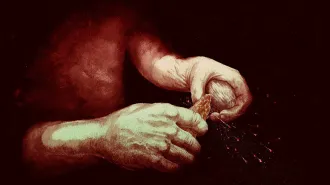From the March 11, 1933, issue

GREAT LION OF LA BREA
Bigger by a fourth than the proudest lion that walks the veldt today were the tallest of the great lions of California a hundred thousand years ago. Rivaled in size only by the short-faced bears whose bones have been found with theirs in the La Brea tar-pits, they could confidently assert their first rights even over the terrible sabre-tooth cats that snarled against them in large numbers. What thunders of roaring shook the skies when giant lion and sabre-tooth faced each other over some luckless bison or camel mired in the asphalt, we can only imagine.
But that these rival killers did live in California at the same time, in the days when the northeastern part of this continent was weighted down under a mile’s thickness of ice, is now quite solidly established. After years of study of their bones, taken in hundreds of thousands from the tar-pits of La Brea in Los Angeles, Dr. John C. Merriam, president of the Carnegie Institution of Washington, and Dr. Chester Stock, paleontologist of the Los Angeles Museum, have presented the results of their research in the newest Carnegie Institution monograph, which makes available to scientists and the public at large both a sweeping general view of the world these tremendous cats knew and an intimate and detailed knowledge of every bone in their bodies.
LIGHTEST WATER MADE, AND NEW RECORD FOR HEAVIEST SET
The world’s lightest weight water, containing the lightest sort of hydrogen and the lightest variety of oxygen, has been manufactured in the chemical laboratories of the U.S. Bureau of Standards in Washington.
Last year Dr. E.W. Washburn, chief of the chemistry division of Uncle Sam’s great scientific establishment, the Bureau of Standards, made what was then the world’s heaviest water. Prof. Harold C. Urey of Columbia University checked the heavy water’s composition with the spectrograph. They reported their achievement in the Proceedings of the National Academy of Sciences and exhibited the water at the American Association for the Advancement of Science meeting in Atlantic City last Christmas week. Now Dr. Washburn has made the lightest water known.
The Bureau of Standards heavy water contains increased amounts of hydrogen isotope two and oxygen isotope eighteen. The lightest water contains increased amounts of hydrogen isotope one and oxygen isotope sixteen. Both, of course, consist of one atom of oxygen and two atoms of hydrogen.
OPTICIAN’S WINDOW NOVELTY MEASURES HEAT FROM STARS
The radiometer–the little whirligig device inside a glass bulb that is often seen spinning around in an optician’s window–has now been used to study the spectrum photographs of stars, which show their composition. This application has been made by Dr. Sinclair Smith and Olin C. Wilson Jr., of the Mt. Wilson Observatory in Pasadena, Calif.







